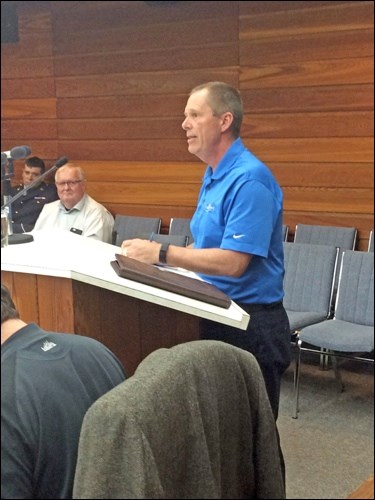Community safety co-ordinator Herb Sutton gave his monthly monitoring report to North Battleford city council Monday, but it had a different format this time.
His report focused on the usual items such as proactive measures, Crime Prevention Through Environmental Design, creating a Community Safety Plan, promoting a positive image and supporting the HUB.
But this time there were also sections of the report devoted specifically to outcomes and impacts.
“I did that because I’m really at a point in my work that I really want to try to challenge myself,” Sutton explained, “and all of the work that I’m doing and I’m involved in, and try to think a little more deeply about the difference that we’re making. What is the impact, what is the outcome of some of the things that we’re involved in.”
A few guests were on hand for Sutton’s presentation and Sutton introduced Ray Van Dusen, with the provincial government, who was responsible for putting together a major report just before Sutton began his role.
Van Dusen’s report in 2014 had made a number of recommendations on public safety and Sutton said they were “about 90 per cent plus of the way through the recommendations” that were made.
Sutton explained to council they had reached a point where a lot of initiatives had begun.
“We picked all the low-hanging fruit. We’ve done a lot of the things that made the most sense to do right away,” said Sutton.
He later identified such things as gathering data and having conversations with people about what to do.
“But now the work really begins around building on the things that we got started, building on our initiatives, sustaining those initiatives and making sure we are getting the results.”
He pointed to two broad areas of focus in that regard. One was the need for “systemic change” and the need to think critically on how to do things and change outcomes, and the other was around “authentic community engagement.”
On the first point, Sutton gave one example of what he was talking about. He spoke once again about the six prolific offenders identified as responsible for 21 per cent of the crime in the downtown core over a two and a half year period.
The individuals were identified and “we’ve agreed that in spite of all the efforts of enforcement folks, it wasn’t effective in changing the pattern of their existence,” said Sutton.
For that, agencies were then brought together to try to deal with their situation, but “we haven’t had any significant changes, to be honest with you,” Sutton admitted. “These individuals are still causing issues in the downtown area.”
He spoke of that as an example of why systemic changes and different approaches needed to be considered.
“My fear is that if we don’t think deeply about systemic changes, we will very quickly revert back to using enforcement, because we have no other choice,” said Sutton.
“That is the last resort. And I think that’s happened maybe too often in some of the things we’ve been trying to work at over the last number of years. The low-hanging fruit was getting the data and having the conversations with folks about what we could do. Now the hard work begins as to really whose responsibility is it and how can we make this work for our community.
“And I think we need to get serious and intentional with our conversations about how we can work differently – otherwise, like you said, we just simply end up reverting back to a situation that we all agreed at the time wasn’t the most effective.”
Sutton also spoke of the need for authentic community engagement, and the need to find ways to get members of the community more involved in those efforts.
In his report, Sutton noted community engagement would be a major focus of SAGE (Safety Acceptance Guidance Empowerment) in 2016. That is the pilot project to promote safety and develop a community safety plan in the city.
As well, they will be working with a student working on a master’s degree in social work whose thesis will be on authentic community engagement.
Sutton said continued support from council was needed, as well as patience.
“The work around systemic change, the work around authentic community engagement is going to take some time,” Sutton said.




